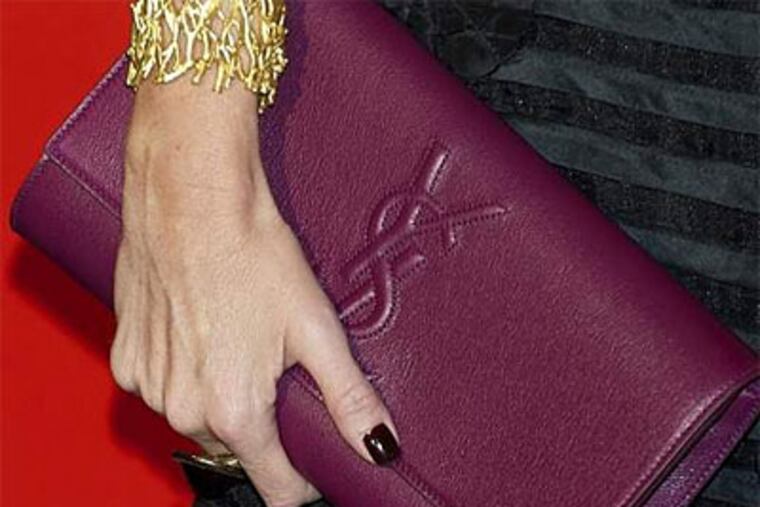Yves Saint Laurent name change may bring sophistication back
When it was announced last week that Yves Saint Laurent was changing the name of its ready-to-wear line to Saint Laurent Paris, fashion purists went into a tweeting tizzy. What about the brand's legacy? What does this mean for luxury? How will YSL survive?

When it was announced last week that Yves Saint Laurent was changing the name of its ready-to-wear line to Saint Laurent Paris, fashion purists went into a tweeting tizzy.
What about the brand's legacy? What does this mean for luxury? How will YSL survive?
Frankly, it's the best way for the Paris-based fashion house to move forward.
Although the YSL logo will remain on handbags, shoes, cosmetics and its boutiques, I'm betting it's only a matter of time before the company goes full throttle Saint Laurent Paris.
Here is why:
The custom-letter logo — created by graphic designer Adolphe Cassandre in 1961 — is, well, everywhere.
The brand may still have luxe prices — a handbag will run you about $2,000 and dresses range from $500 to $700 — but who can claim exclusivity when everyone seems to own a piece of it, real or knock off?
Reality housewives, basketball wives and starting Wednesday, Hollywood's ex-wives, have all but killed the cache of luxury. How classy is a label when Atlanta Housewife NeNe "I'm very rich bitch" Leakes is dropping F-bombs while wearing YSL shoes, holding a YSL bag and rocking YSL pants? The so-called sophistication of high-end brands diminishes with every reality television show episode.
What's a luxury label to do?
I believe YSL has decided to distance itself from itself.
"This is a brand that has been licensed all over the place and its lost some of its luxe," explained Pamela N. Danziger, the Lancaster-based author of Putting the Luxe Back in Luxury (Paramount Marketing Publishing, 2011). "These brands are common now. For many luxury brands, their popularity is their Achilles' heel."
YSL is among the first of the luxury brands to separate it's haute couture label from the franchise it built. In doing so, fashion experts say creative director Hedi Slimane is trying to reestablish the company's standing on the runway and appeal to younger wealthy customers who aren't aware of the brand's rich fashion history. Saint Laurent Paris is a nod to the company's past — namely, a mid-1960s luxe collection named Saint Laurent Rive Gauche — which refers to the Left Bank river in Paris. (That said, Saint Laurent Paris will most likely be designed in Los Angeles where Silmane moved the design studio.)
"The change celebrates our legacy and heritage, while boldly marking our ambition for the future," CEO Paul Deneve said in a statement, the only official comment on the change from the company.
Before YSL aviator frames, Opium perfume and its run of "it" bags, YSL was simply Yves Saint Laurent, a French designer who, with business partner and lover Pierre Berge, brought the slimming beatnik look to women's fashion in the late 1960s and '70s. Saint Laurent was responsible for the women's pantsuit, the belted safari jacket and a tuxedo jacket affectionately known as Le Smoking.
This year's color-blocking look is rooted in the Saint Laurent-aesthetic; it was the bespectacled designer who replicated painter Piet Mondrian's red, blue and yellow pattern on an A-line sheath.
In 1998, Yves Saint Laurent was sold to the Gucci Group, which then licensed the brand to accessories makers. Berge and Saint Laurent stayed with the company until they retired in 2002; Saint Laurent died in 2008.
Top designers including Tom Ford and Stefano Pilati took over the helm; however, it has been nearly impossible for YSL to maintain the greatness of its glory days when fine craftsmanship and sumptuous fabrics helped to define a label as special. At one point, the same could be said for Gucci, Chanel, Luis Vuiton.
These days a Google search can easily lead to online sample sales and discount coupons. That makes it a challenge for the luxury brands to convince young consumers more interested in haute than history to invest in the labels, especially when everyone — even the affluent — are closely monitoring where they spend their money. Candace Corlett, president of WSL Strategic Retail, says young people don't mind mixing high-end and low-end, either.
A rebranding effort in this kind of climate might spark some interest, say industry marketers. But the change, which comes with its own costs, might be a bit too little, too late.
"Yes it will create buzz, but it may not be worth what it might cost them in revenue," said Nikolas Contis, global director of naming for branding firm Siegel + Gayle. "They may end up creating a Muzak version of themselves," Contis said. In other words, Yves Saint Laurent Paris sounds more like a designer label adopted for the department store than a luxury fashion line. They might be better off focusing on their product, Contis said.
The success of the change will come down to how people view those famous letters, Corlett said.
"YSL has become more of an acronym than the initials of the famous designer. It's a smart move aimed at recapturing the brand name and repositioning it back to the dignity you had at the same time. But that will only work if YSL doesn't become SLP."
Eventually, even the YSL moniker will become so yester year — a symbol of when conspicuous consumption was at the center of high fashion — and Saint Laurent Paris will be the face of a new brand. The knock-offs will come — how can you stop them? But at least the new label will have a few unspoiled years while it builds a future — especially if Silmane can come up with a look we haven't seen before. And that's a lot harder than changing a name.